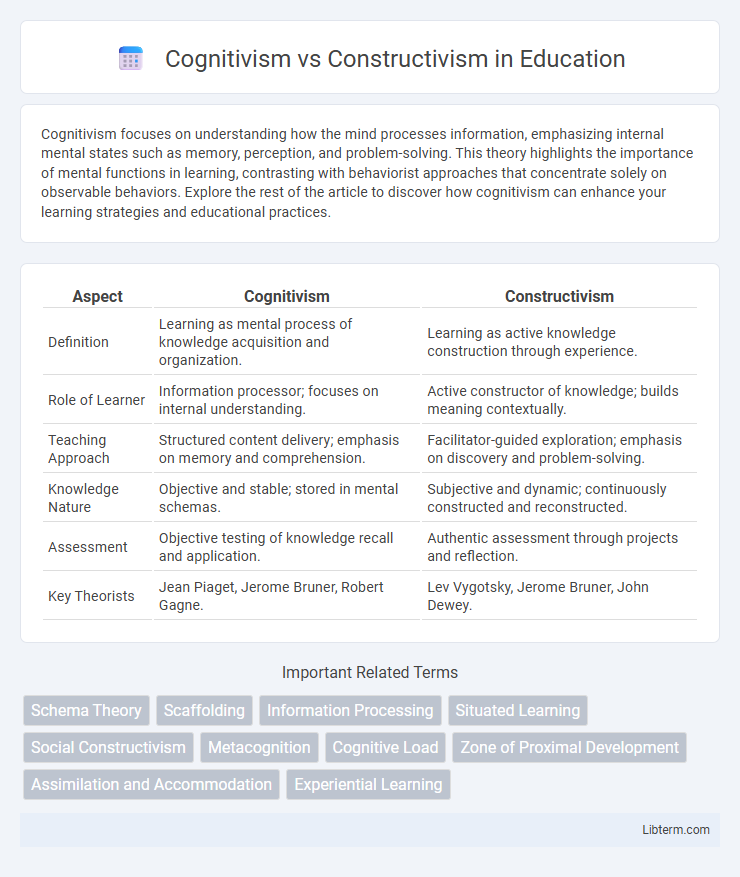Cognitivism focuses on understanding how the mind processes information, emphasizing internal mental states such as memory, perception, and problem-solving. This theory highlights the importance of mental functions in learning, contrasting with behaviorist approaches that concentrate solely on observable behaviors. Explore the rest of the article to discover how cognitivism can enhance your learning strategies and educational practices.
Table of Comparison
| Aspect | Cognitivism | Constructivism |
|---|---|---|
| Definition | Learning as mental process of knowledge acquisition and organization. | Learning as active knowledge construction through experience. |
| Role of Learner | Information processor; focuses on internal understanding. | Active constructor of knowledge; builds meaning contextually. |
| Teaching Approach | Structured content delivery; emphasis on memory and comprehension. | Facilitator-guided exploration; emphasis on discovery and problem-solving. |
| Knowledge Nature | Objective and stable; stored in mental schemas. | Subjective and dynamic; continuously constructed and reconstructed. |
| Assessment | Objective testing of knowledge recall and application. | Authentic assessment through projects and reflection. |
| Key Theorists | Jean Piaget, Jerome Bruner, Robert Gagne. | Lev Vygotsky, Jerome Bruner, John Dewey. |
Introduction to Learning Theories
Cognitivism centers on how the mind processes, stores, and retrieves information, emphasizing internal mental functions such as perception, memory, and problem-solving. Constructivism focuses on learning as an active, constructive process where learners build new knowledge based on their experiences and prior understanding, often through social interactions. Both theories influence educational practices by shaping instructional design, with cognitivism prioritizing structured information delivery and constructivism advocating for experiential, learner-centered environments.
Defining Cognitivism: Core Principles
Cognitivism centers on understanding internal mental processes such as perception, memory, and problem-solving that drive learning. It emphasizes the role of structured knowledge acquisition through information processing and cognitive organization within the brain. Core principles include schema theory, whereby learners actively connect new information to existing cognitive frameworks, and the significance of rehearsal and encoding strategies in enhancing retention and comprehension.
Key Tenets of Constructivism
Constructivism emphasizes that learners actively construct knowledge through experience and reflection, highlighting the importance of prior knowledge and social interaction in the learning process. It posits that understanding is personalized and context-dependent, with learners building meaning by connecting new information to existing cognitive frameworks. This approach contrasts with Cognitivism by prioritizing learner-centered discovery, collaboration, and real-world problem solving.
Historical Background and Key Contributors
Cognitivism emerged in the mid-20th century as a response to behaviorism, with key contributors like Jean Piaget and Ulric Neisser emphasizing mental processes such as memory and problem-solving. Constructivism, influenced by Piaget and Lev Vygotsky, developed as an educational theory highlighting learners' active role in constructing knowledge through experience and social interaction. Both paradigms significantly shaped modern educational psychology, with cognitivism focusing on internal cognitive functions and constructivism emphasizing contextual and social learning.
How Cognitivism Approaches Knowledge Acquisition
Cognitivism approaches knowledge acquisition by emphasizing mental processes such as perception, memory, and problem-solving, treating the mind as an information processor. It focuses on understanding how learners internalize and organize knowledge through schemas and cognitive structures. This theory supports structured learning environments where information is presented clearly to enhance cognitive development and retention.
Constructivist Views on Learning and Understanding
Constructivist views on learning emphasize active knowledge construction through personal experiences and social interactions, asserting that learners build understanding by integrating new information with existing cognitive frameworks. This approach prioritizes learners' autonomy and contextualized problem-solving, fostering deeper comprehension and critical thinking skills. Educational strategies aligned with constructivism include collaborative projects, inquiry-based tasks, and reflection, which encourage learners to create meaning rather than passively receive information.
Comparison: Cognitivism vs Constructivism in the Classroom
Cognitivism emphasizes structured instruction, focusing on mental processes like memory and problem-solving through clear objectives and guided practice, while constructivism prioritizes active student engagement and knowledge construction through exploration and collaboration. In the classroom, cognitivist approaches often use direct teaching and scaffolding to support information processing, whereas constructivist methods encourage students to develop understanding by connecting new experiences to prior knowledge. The choice between these theories influences lesson design, assessment strategies, and the role of the teacher as either a knowledge transmitter or a facilitator of learning.
Advantages and Limitations of Cognitivism
Cognitivism emphasizes the role of mental processes such as thinking, memory, and problem-solving in learning, allowing for structured knowledge acquisition and efficient information processing. One advantage is its focus on internal cognitive structures, which aids in developing instructional designs that enhance comprehension and retention. However, limitations include underestimating the social context of learning and neglecting the active construction of knowledge highlighted by constructivist approaches.
Strengths and Challenges of Constructivist Methods
Constructivist methods promote active learning by encouraging students to build knowledge through experience and collaboration, enhancing critical thinking and problem-solving skills. These approaches foster deep understanding and learner autonomy but can pose challenges such as increased demand on instructor facilitation skills and potential inconsistencies in knowledge acquisition. Effective implementation requires balancing guidance with exploration to maximize engagement while ensuring curriculum objectives are met.
Practical Applications and Future Directions
Cognitivism enhances practical applications in education through structured learning techniques that emphasize information processing, memory retention, and problem-solving strategies, enabling efficient skill acquisition and knowledge transfer. Constructivism promotes active, student-centered learning environments where learners build understanding through experience, collaboration, and reflection, fostering critical thinking and adaptability. Future directions involve integrating cognitive science advancements with digital technologies and adaptive learning platforms to create personalized, immersive, and scalable educational solutions that combine the strengths of both theories.
Cognitivism Infographic

 libterm.com
libterm.com